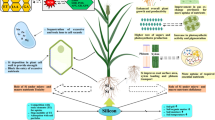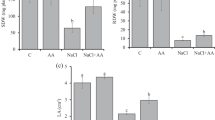Abstract
Environmental factors often affect plant growth bymodifying the levels of endogenous gibberellins (GAs).In this study, the involvement of GAs in theregulation of enhanced shoot growth in tomato (Lycopersicon esculentum Mill.) plants grown in soiltreated by solarization (a soil disinfestation method)was investigated. Seedlings at the cotyledonary stagewere transplanted into either solarized or untreatedcontrol soil. Plants in both soils grew free of anydisease symptoms. As soon as four days after planting,seedlings in solarized soil had a higher dry weightcompared to the control. Throughout most of theexperimental period of 18 days, leaf weight ratio washigher in the solarized vs. the control soil. Treatingshoot tips of control plants with 0.1 mg.L-1GA3 resulted in enhanced leaf and stem growth,thus reaching values similar to those of plants grownin solarized soil. The opposite effect was obtained bytreating plants grown in solarized soil with1 mg.L-1 uniconazole, a GA biosynthesisinhibitor. Quantitative GC-MS analyses revealed thatGA1 content in one and two-weeks old transplantsgrown in various solarized soils was up to 1.8 fold,and that GA3 content in two-weeks old plants wasup to five fold the values in the control. Theseincreases were linearly correlated with the increasein leaf dry weight. It was concluded that theincreased quantities of GA1, and eventuallyGA3, play a role in the increased growth oftomato shoots in solarized soil as early as seven daysafter transplanting.
Similar content being viewed by others
References
Ali IA, Kafkafi U, Yamaguchi I, Sugimoto Y and Inanaga S (1996) Effects of low root temperature on sap flow rate, soluble carbohydrates, nitrate contents and on cytokinin and gibberellin levels in root xylem exudate of sand-grown tomato. J Plant Nutr 19: 619-634
Barlow PW, Brain P and Parker JS (1991) Cellular growth in roots of a gibberellin-deficient mutant of tomato (Lycopersicon esculentum Mill.) and its wild-type. J Exp Bot 42: 339-352
Bensen RJ, Beall FD, Mullet JE and Morgan PW (1990) Detection of endogenous gibberellins and their relationship to hypocotyl elongation in soybean seedlings. Plant Physiol 94: 77-84
Butcher DN, Appleford NEJ, Hedden P and Lenton JR (1988) Plant growth substances in root cultures of Lycopersicon esculentum. Phytochemistry 27: 1575-1578
Butcher DN, Clark JA and Lenton JR (1990) Gibberellins and the growth of excised tomato roots: Comparison of gib-1 mutant and wild type and responses to applied GA3 and 2S, 3S paclobutrazol. J Exp Bot 41: 715-722
Chen Y and Katan J (1980) Effect of solar heating of soils by transparent polyethylene mulching on their chemical properties. Soil Sci 130: 271-277
Chen Y, Gamliel A, Stapleton JJ and Aviad T (1991) Chemical, physical, and microbial changes related to plant growth in disinfested soil. In: Katan J and DeVay JE (eds) Soil Solarization. Boca Raton: CRC Press, pp. 103-130
Cramer MD, Nagel OW, Lips SH and Lambers H (1995) Reduction, assimilation and transport of N in normal and gibberellin-deficient tomato plants. Physiol Plant 95: 347-354
Davies TD, Ells JE and Walser RH (1990) Emergence, growth, and freezing tolerance of tomato seedlings grown from uniconazole-treated seed. HortScience 25: 312-313
Fray RG, Wallace A, Fraser PD, Valero D, Hedden P, Bramley PM and Grierson D (1995) Constitutive expression of a fruit phytoene synthase gene in transgenic tomatoes causes dwarfism by redirecting metabolites from the gibberellin pathway. Plant J 8: 693-701
Fulchieri M, Lucangeli C and Bottini R (1993) Inoculation with Azospirillum lipoferum affects growth and gibberellin status of corn seedling roots. Plant Cell Physiol 34: 1305-1309
Gamliel A and Katan J (1991) Involvement of fluorescent pseudomonads and other microorganisms in increased growth response of plants in solarized soils. Phytopathology 81: 494-502
Grünzweig JM, Rabinowitch HD and Katan J (1993) Physiological and developmental aspects of increased plant growth in solarized soils. Ann Appl Biol 122: 579-591
Grünzweig JM, Rabinowitch HD, Katan J, Wodner M and Ben-Tal Y (1997) Endogenous gibberellins in tomato foliage (Lycopersicon esculentum). Phytochemistry 46: 811-815
Grünzweig JM, Katan J, Ben-Tal Y, and Rabinowitch HD (1999) The role of mineral nutrients in the increased growth response of tomato plants in solarized soil. Plant Soil 206: 21-27
Hedden P and Lenton JR (1988) Genetical and chemical approaches to the metabolic regulation and mode of action of gibberellins in plants. In: Steffens GL and Rumsey TS (eds) Biomechanisms Regulating Growth and Development. Beltsville Symposia in Agricultural Research, Vol. 12 Dordrecht: Kluwer Academic, pp. 175-204
Jensen E, Eilertsen S, Ernsten A, Juntilla O and Moe R (1996) Thermoperiodic control of stem elongation and endogenous gibberellins in Campanula isophylla. J Plant Growth Regul 15: 167-171
Jones MG (1987) Gibberellins and the procera mutant of tomato. Planta 172: 280-284
Katan J (1981) Solar heating (solarization) of soil for control of soilborne pests. Ann Rev Phytopath 19: 211-236
Katan J and DeVay JE (1991) Soil Solarization. Boca Raton: CRC Press.
Katznelson H and Cole SE (1965) Production of gibberellin-like substances by bacteria and actinomycetes. Can J Microbiol 11: 733-741
Koornneef M, Bosma TDG, Hanhart CJ, van der Veen JH and Zeevaart JAD (1990) The isolation and characterization of gibberellin-deficient mutants in tomato. Theor Appl Genet 80: 852-857
Krauss A and Marschner H (1982) Influence of nitrogen nutrition, daylength and temperature on contents of gibberellic and abscisic acid and on tuberization in potato plants. Potato Res 25: 13-21
Noodén LD (1988) Abscisic acid, auxins, and other regulators of senescence. In: Noodén LD and Leopold AC (eds): Senescence and Aging in Plants. San Diego: Academic Press, pp. 329-368
Phinney BO (1984) Gibberellin A1, dwarfism and the control of shoot elongation in higher plants. In: Crozier A and Hillman JR (eds) The Biosynthesis and Metabolism of Plant Hormones. Cambridge: Cambridge University Press, pp. 17-41
Rademacher W (1994) Gibberellin formation in microorganisms. Plant Growth Regul 15: 303-314
Reid JB and Howell SH (1995) Hormone mutants and plant development. In: Davies, PJ (ed.) Plant Hormones: Physiology, Biochemistry and Molecular Biology, 2nd edition. Dordrecht: Kluwer Academic, pp. 448-485
Rood SB, Pearce D, Williams PH and Pharis RP (1989) A gibberellin-deficient Brassica mutant-rosette. Plant Physiol 89: 482-487
Ross JJ, Murfet IC and Reid JB (1993) Distribution of gibberellins in Lathyrus odoratus L. and their role in leaf growth. Plant Physiol 102: 603-608
Spray CR, Kobayashi M, Suzuki Y, Phinney BO, Gaskin P and MacMillan J (1996) The dwarf-1 (d1) mutant of Zea mays blocks three steps in the gibberellin-biosynthetic pathway. Proc Natl Acad Sci USA 93: 10515-10518
Tanimoto E (1994) Interaction of gibberellin A3 and ancymidol in the growth and cell-wall extensibility of dwarf pea roots. Plant Cell Physiol 35: 1019-1028
Zanewich KP and Rood SB (1995) Vernalization and gibberellin physiology of winter canola. Endogenous gibberellin (GA) content and metabolism of [3H]GA1 and [3H]GA20. Plant Physiol 108: 615-621
Zeevaart JAD, Gage DA and Talon M (1993) Gibberellin A1 is required for stem elongation in spinach. Proc Natl Acad Sci USA 90: 7401-7405
Author information
Authors and Affiliations
Additional information
deceased
Rights and permissions
About this article
Cite this article
Grünzweig, J.M., Rabinowitch, H.D., Katan, J. et al. Involvement of endogenous gibberellins in the regulation of increased tomato shoot growth in solarized soil. Plant Growth Regulation 30, 233–239 (2000). https://doi.org/10.1023/A:1006368626210
Issue Date:
DOI: https://doi.org/10.1023/A:1006368626210




